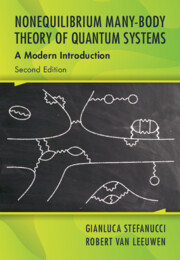Refine search
Actions for selected content:
3336 results in Quantum Physics, Quantum Information and Quantum Computation
14 - Two-Particle Green’s Function: Diagrammatic Expansion
-
- Book:
- Nonequilibrium Many-Body Theory of Quantum Systems
- Published online:
- 02 January 2025
- Print publication:
- 16 January 2025, pp 357-410
-
- Chapter
- Export citation
Appendix P: - Kramers–Kronig Relations
-
- Book:
- Nonequilibrium Many-Body Theory of Quantum Systems
- Published online:
- 02 January 2025
- Print publication:
- 16 January 2025, pp 673-674
-
- Chapter
- Export citation
Preface to the First Edition
-
- Book:
- Nonequilibrium Many-Body Theory of Quantum Systems
- Published online:
- 02 January 2025
- Print publication:
- 16 January 2025, pp xv-xviii
-
- Chapter
- Export citation
Dedication
-
- Book:
- Nonequilibrium Many-Body Theory of Quantum Systems
- Published online:
- 02 January 2025
- Print publication:
- 16 January 2025, pp v-vi
-
- Chapter
- Export citation
6 - One-Particle Green’s Function: Exact Results
-
- Book:
- Nonequilibrium Many-Body Theory of Quantum Systems
- Published online:
- 02 January 2025
- Print publication:
- 16 January 2025, pp 147-194
-
- Chapter
- Export citation
Appendix A: - From the N Roots of 1 to the Dirac δ-Function
-
- Book:
- Nonequilibrium Many-Body Theory of Quantum Systems
- Published online:
- 02 January 2025
- Print publication:
- 16 January 2025, pp 573-576
-
- Chapter
- Export citation
References
-
- Book:
- Nonequilibrium Many-Body Theory of Quantum Systems
- Published online:
- 02 January 2025
- Print publication:
- 16 January 2025, pp 675-688
-
- Chapter
- Export citation
Abbreviations and Acronyms
-
- Book:
- Nonequilibrium Many-Body Theory of Quantum Systems
- Published online:
- 02 January 2025
- Print publication:
- 16 January 2025, pp xix-xx
-
- Chapter
- Export citation
15 - Electron Gas: Equilibrium and Nonequilibrium Correlation Effects
-
- Book:
- Nonequilibrium Many-Body Theory of Quantum Systems
- Published online:
- 02 January 2025
- Print publication:
- 16 January 2025, pp 411-450
-
- Chapter
- Export citation
2 - Getting Familiar with Second Quantization: Model Hamiltonians
-
- Book:
- Nonequilibrium Many-Body Theory of Quantum Systems
- Published online:
- 02 January 2025
- Print publication:
- 16 January 2025, pp 35-78
-
- Chapter
- Export citation

Nonequilibrium Many-Body Theory of Quantum Systems
- A Modern Introduction
-
- Published online:
- 02 January 2025
- Print publication:
- 16 January 2025
14 - Approximation Methods
-
- Book:
- Quantum Mechanics through Problems
- Published online:
- 05 December 2024
- Print publication:
- 12 December 2024, pp 433-515
-
- Chapter
- Export citation
6 - Mathematical Formulation of Quantum Mechanics
-
- Book:
- Quantum Mechanics through Problems
- Published online:
- 05 December 2024
- Print publication:
- 12 December 2024, pp 155-191
-
- Chapter
- Export citation
Acknowledgments
-
- Book:
- Quantum Mechanics through Problems
- Published online:
- 05 December 2024
- Print publication:
- 12 December 2024, pp xxi-xxii
-
- Chapter
- Export citation
7 - Physical Interpretation: Postulates of Quantum Mechanics
-
- Book:
- Quantum Mechanics through Problems
- Published online:
- 05 December 2024
- Print publication:
- 12 December 2024, pp 192-223
-
- Chapter
- Export citation
15 - Scattering by a Potential
-
- Book:
- Quantum Mechanics through Problems
- Published online:
- 05 December 2024
- Print publication:
- 12 December 2024, pp 516-581
-
- Chapter
- Export citation
Contents
-
- Book:
- Quantum Mechanics through Problems
- Published online:
- 05 December 2024
- Print publication:
- 12 December 2024, pp vii-xviii
-
- Chapter
- Export citation
9 - Particle in a Central Potential; Orbital Angular Momentum
-
- Book:
- Quantum Mechanics through Problems
- Published online:
- 05 December 2024
- Print publication:
- 12 December 2024, pp 270-290
-
- Chapter
- Export citation
13 - Addition of Angular Momenta
-
- Book:
- Quantum Mechanics through Problems
- Published online:
- 05 December 2024
- Print publication:
- 12 December 2024, pp 411-432
-
- Chapter
- Export citation
8 - The Harmonic Oscillator
-
- Book:
- Quantum Mechanics through Problems
- Published online:
- 05 December 2024
- Print publication:
- 12 December 2024, pp 224-269
-
- Chapter
- Export citation
